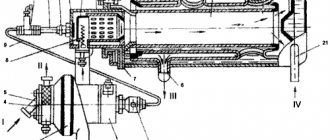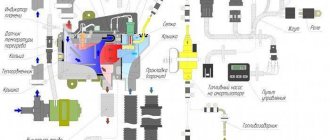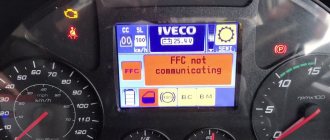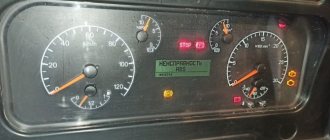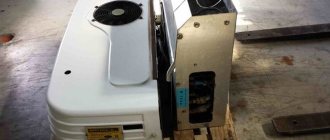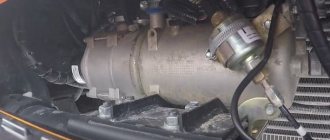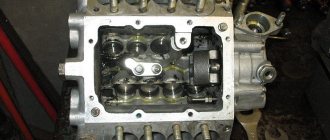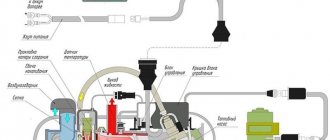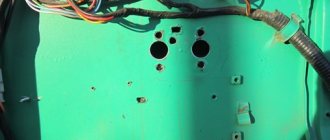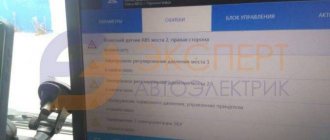Description of the device
Preheating of a diesel engine occurs due to the presence of a liquid cooling system. The device is designed for installation directly into the vehicle cooling system itself. The heating itself occurs as a result of combustion of the air-fuel mixture, which comes from the vehicle’s fuel system. The device operates from the standard power supply system. A special pump is provided for pumping liquid in the PZD system.
Complete set of PZD 14TS-10
As written earlier, the main purpose of the PZD 14TS-10 is to warm up the engine before operation. Fuel, burning in a special compartment, heats the heat exchanger and transfers heat to the cooling system. The liquid begins to circulate and gradually warms up the entire engine. This system is ideal for preheating and preheating in economy mode. In the second case, it should be taken into account that the efficiency of the system is significantly lower.
Using a special program, the combustion chamber is first purged. After this, the glow plug begins to warm up to a certain temperature, which ignites the combustible mixture. The combustion process is controlled using sensors and a control unit.
As for the scope of application of the PZD 14TS-10, it includes: freight transport, buses and special equipment.
Malfunctions of heater control system elements
Troubleshooting must begin by checking the contacts of the connectors of the circuits being tested (see the electrical connection diagram in Fig. 1). All other heater malfunctions that have occurred are listed below.
Number of LED flashes: LED not lit
Fault: The heater does not start.
Debugg:
- Check the 25 A fuse and replace if necessary.
- Check the control panel and replace if necessary.
- Check electrical wiring.
- Check the connectors and, if necessary, remove oxidation from the connector contacts.
Number of LED flashes: 1
Fault: Overheating
Troubleshooting: The overheating sensor or temperature sensor produces a temperature above 102 °C. Check the complete fluid circuit and the operation of the circulation pump.
Fault: Possible overheating detected. The temperature difference between the overheating sensor and the temperature sensor is too large.
Troubleshooting: The difference in temperature values measured by the overheating sensor and the temperature sensor is more than 20 °C (the temperature value from the overheating sensor is more than 85 °C or the temperature sensor is more than 70 °C). Check the overheating sensor and temperature sensor and replace if necessary. Check the operation of the circulation pump.
Number of LED flashes: 2
Fault: Start attempts exhausted
Troubleshooting: If the permissible number of starting attempts has been used, check the quantity and supply of fuel. Check the combustion air supply system and the exhaust pipe.
Number of LED flashes: 3
Fault: Flame interruption
Troubleshooting: Check the quantity and supply of fuel. Check the combustion air supply system and the exhaust pipe. If the heater starts, check the flame indicator and replace if necessary. Check the fine fuel filter for clogging.
Number of LED flashes: 4
Fault: Glow plug fault
Troubleshooting: Check the glow plug, replace if necessary.
Fault: Blower motor malfunction
Troubleshooting: Check the electrical wiring of the air blower motor and, if necessary, replace the air blower.
Number of LED flashes: 5
Fault: Flame indicator fault.
Troubleshooting: Check connecting wires. Check the ohmic resistance between the indicator contacts, which should be no more than 1 Ohm.
Number of LED flashes: 6
Malfunction:
- Overheat sensor malfunction
- Temperature sensor malfunction
Troubleshooting: Check connecting wires. The output signal and voltage are linearly dependent on temperature (0 °C corresponds to 2.73 V and with an increase in temperature by 1 °C, the output signal increases by 10 mV). Check the sensor and replace if necessary.
Number of LED flashes: 7
Fault: Circulation pump fault
Troubleshooting: Check the electrical wires of the circulation pump for short circuits, check the circulation pump and replace if necessary.
Fault: Fuel pump malfunction.
Troubleshooting: Check the fuel pump electrical wires for short circuits, check the fuel pump for performance and replace if necessary.
Number of LED flashes: 9
Fault: Shutdown, overvoltage
Troubleshooting: Check the battery, regulator and supply wiring. The voltage between pins 4 and 7 of the XS1 connector should be no higher than 30 V.
Fault: Shutdown, undervoltage/
Troubleshooting: Check the battery, regulator and supply wiring. The voltage between pins 4 and 7 of the XS1 connector must be at least 20 V
Number of LED flashes: 10
Fault: Ventilation time exceeded
Troubleshooting: The heater is not cooled sufficiently during purging. Check the combustion air supply system and the exhaust pipe. Check the flame indicator and replace if necessary.
Basic operating modes
In total, there are two main working programs in the PZD 14TS-10 device: “Pre-start” and “Economic”. Each of them is selected by the operator depending on the tasks and ambient temperature. In addition to programs, the PZD system provides three main operating modes:
- "Full". Within this mode, it is assumed that the liquid in the cooling system is heated to a temperature of 60 to 70 ° C;
- "Average". During this mode, the heating temperature of the liquid fluctuates between 70 - 75 ° C;
- "Small". This mode allows you to heat the liquid system up to 80 °C.
As soon as the operating temperature in the cooling system exceeds 80 ° C, the system automatically stops fuel combustion, while the pump operates in normal mode to heat the passenger compartment. As soon as the liquid temperature drops below 55 °C, the air-fuel mixture begins combustion and the heating process again. As for the duration of the full operating cycle, in the “Pre-start” program it is 3 hours, and in the “Economy” mode the maximum operating time increases to 8 hours. At the same time, if necessary, the PZD system can be turned off independently at any time.
Appearance Equipment PZD 14TS-10.
Design and operating principle of 14TS-10
The 14TS 10 device is a special device built into a break in the circuit of the engine liquid cooling system. Structurally, it consists of a housing in which a combustion chamber, a built-in heat exchanger and an electric pump are located. Switching on and monitoring the operation of the heater is carried out by a control unit with a remote control. The heater is connected to the fuel system and on-board electrical network of the vehicle.
When fuel burns in the heater chamber, heat is released, which is transferred to the heat exchanger. The liquid passing through it is heated and, with the help of a built-in pump, circulates in the engine water cooling system.
The camera operation process is controlled by a combustion indicator. Having reached the specified heating temperature limit (80°C), combustion stops and the device begins to cool down. The heated liquid continues to circulate in the system.
Automatic operation of the 14TC-10 is carried out according to one of the selected programs: economical or pre-start. In the first case, the operating cycle lasts 8 hours at low power, in the second, heating occurs in 3 hours at maximum power.
What does the control unit and the device control panel do?
The PZD 14TS-10 control unit performs all the main tasks of monitoring the operation of the device. It performs initial diagnostics for the presence of faults in system nodes, ensures switching of programs and operating modes, and also directly controls the operating process itself.
The control panel is required to manually control the operation of the control unit. Using the remote control, the operator can independently turn the system on and off, switch operating programs, set the heating temperature and operating time of the system. You can also use it to view system performance indicators.
Purpose of heaters
Today, almost no truck in Russia can do without an engine preheating device. The harsh climatic conditions of our country require a comprehensive solution to the issue of engine pre-start preparation. One of such solutions is the Teplostar 14TS-10 diesel heater, supplied to the main conveyor of many large car assembly plants. This multifunctional device provides:
- Pre-start preparation of the engine in the cold season;
- Maintaining the thermal state of a truck engine for a long time (reheater mode);
- Defrosting car cabin windows.
Basic mistakes and ways to solve them
A distinctive feature of the PZD 14TS-10 system is that the operator can independently determine the cause of the breakdown. For this, the developer has provided a special LED identification system. All you need to do is count the number of times the LED blinks. Then, depending on their number from 1 to 10, the operator can find out the reason and method of repairing the device. Error codes and instructions for solving them are presented in the image below. We recommend that you copy this table and keep it in your car to quickly resolve the problem.
Description of PZD errors 14.
Applicability
The Teplostar diesel preheater is reliable, easy to operate and has low maintenance and repair costs. The lion's share of consumption of these autonomous vehicles falls on primary buyers - large automobile manufacturers: factories for the production of MAZ, PAZ trucks, tractor factories, special equipment factories and others.
Teplostar 14TS-10 are also mounted on trucks from European and American manufacturers, when repairing an imported heater is not cost-effective or long-term due to the lack of spare parts.
It is worth noting that the use of this heater does not end with trucks. Very often they can be found in the configurations of mobile diesel stations and diesel generators operating in cold conditions.
There are often cases when the Teplostar “pre-starter” is even used for heating a room, for example, it is connected to a heating system that has radiators with a circulating coolant (antifreeze, water).
Pramotronik 30ZhD24, 35Zh24, 141.8106
| Code | Malfunction | Possible reasons |
| There is no tension. Lamps HL1 and HL2 do not light up when the heater is turned on. | Poor contact in electrical connections. The fuse has blown. Poor contact at the battery terminals. Break in the heater power wiring harness. The polarity of the heater power wires on the battery is reversed. | |
| 2 | The heater does not start. | Poor contact in electrical connections. Lack of fuel. The fuel filter is clogged. The tightness in the suction line of the heater fuel line is broken. Thickening of fuel in the fuel line during climate change. |
| 7 | The heater does not start. | Open circuit in the electric pump circuit. |
| 1 | Flame failure during heater operation. | Lack of fuel. The fuel suction line is not tight. Thickening of fuel in the fuel line during climate change. |
| 8 | Solenoid valve circuit malfunction. | Solenoid valve circuit malfunction. The heat exchanger overheated, the thermal fuse tripped. |
| 3 | The supply voltage does not meet the specified limits. | Malfunction of the ATS voltage regulator. |
| 4 | The supply voltage does not meet the specified limits. | The battery is discharged. |
Pramotronik 143.8106
| Code | Malfunction | Possible reasons |
| – | There is no tension. The HG27 lamp does not light up when the heater is turned on. | Poor contact in electrical connections. Break in the power supply circuit using thermobimetallic fuse FU25. Poor contact at the battery terminals. Break in the heater power wiring harness. The polarity of the heater power wires on the battery is reversed. |
| 2 | The heater does not start. | Poor contact in electrical connections. Lack of fuel. The fuel filter is clogged. The tightness in the supply line of the heater fuel line is broken. Thickening of fuel in the fuel line during climate change. |
| 9 | The heater does not start. | Open circuit in the electric pump circuit. |
| 1 | Flame failure during heater operation. | Lack of fuel. The tightness in the supply line of the heater fuel line is broken. Solidification of fuel in the fuel line during climate change. |
| 7 | Solenoid valve circuit malfunction. | Solenoid valve circuit malfunction. The heat exchanger overheated, the heater thermal fuse tripped. |
| 10 | The supply voltage does not meet the specified limits. | Malfunction of the ATS voltage regulator. |
| 3 | The supply voltage does not meet the specified limits. | The battery is discharged. |
PZD 14TS-10: instructions, installation, troubleshooting
The main task of the 14TS-10 pre-start diesel heater is to prepare the engine, that is, to warm up the liquid cooling system before leaving . When the fuel burns, heat is released in the chamber, which passes through the walls of the heat exchanger. At this moment, the coolant mixture heats up and circulates through the vehicle’s cooling system.
The device can operate in two modes: economical (cycle duration is 8 hours) or pre-start (3 hours). It should be noted that the power consumption in the second case is much higher. According to this plan, purging of the combustion chamber begins. The glow plug reaches the desired temperature, and only then fuel and air begin to flow into the chamber. This is how combustion occurs. The flame indicator controls this process, and the control unit is designed to control the operation of the entire vehicle 14.
In this video you will learn the specifics of the engine preheater:
We hope this material has given you an idea of what PZD 14TS-10 is, and also explained the main errors and how to solve them. If you have any questions, you can ask them in the comments.
Read also: Kia Sid chain replacement
The parking heater (in common parlance, autonomous heater) on KamAZ is used to heat the cab when the main engine is not running. Depending on the design, devices are divided into “dry” and “wet”. The first ones use a flame torch to heat the air that is supplied to the cabin, and the second ones heat the coolant of the car’s engine cooling system. In this case, the cabin is heated by a standard stove.
